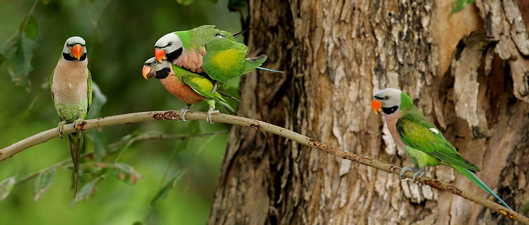Robson’s Birds of South-east Asia lists the subspecies of the Red-breasted Parakeet (Psittacula alexandri) occuring in the region as fasciata. Local birders have never been seriously interested in the bird, probably because it is an escapee. Also, with a pair of binoculars, it is not easy to seriously study the detailed characters in the field. However, with many photographers now showing an interest in birds, we have begin to accumulate a collection of excellent images that can be closely examined and even sent to the relevant experts for ID confirmation.
With the assistance of Joseph M Forshaw, an international expert on parrots, we have established that in at least one population of these birds in Changi, the subspecies is alexandri. In the image below, the two males on either side of the mating pair are distinctly alexandri. And according to Forshaw, the mating male shows a slight tendency towards fasciata as the breast is slightly darker.
The mating female, however, cannot be alexandri as the lower mandible is black, and the female of that subspecies has coral-red bill. However, according to Forshaw (2006): she has “the deep pink of breast… continuing up side of neck in front of emerald-green hindneck;” and this indicates that she is a female fasciata (left, arrow). The adult female of this subspecies has “bill entirely black” while this bird has red upper mandible but black lower mandible, indicating she may be a subadult.
We subsequently located another mating pair: the male was an alexandri while the female a possible older subadult fasciata with black lower and slightly black upper mandible (right). As the juvenile of this latter subspecies has red bill (below), it is most probably that with maturity the lower mandible turn black, soon to be followed with the upper also becoming black. With full adulthood the female develops a fully black bill.
As Forshaw added: “Juvenile fasciata does have an all-red bill, and the adult female has an all-black bill, so we can expect subadults to have varying amounts of red and black in the bill.
“Of course, it is probable that alexandri x fasciata adult females will retain permanently the mixed red-black bill, or this could apply even to adult female alexandri with some past gene flow from fasciata. I am more confident that the Singapore population is a mix of the two subspecies, even though alexandri-looking birds now may be becoming more prevalent.”
Our population of Red-breasted Parakeet originated from the caged birds trade. Both alexandri and fasciata must have escaped into the wild and are now breeding successfully, resulting in hybrids between the two subspecies. Obviously we need more field observations, especially the developmental stages of the female fasciata bill.
Joseph M Forshaw & YC Wee
May 2007
(Images by Chan Yoke Meng)
Reference:
Forshaw, J. M. (2006). Parrots of the world: An identification guide. Princeton & Oxford: Princeton University Press (Plate 42).













One Response
HI
I am the magazine editor for the Parrot Society of New Zealand. I had a read of this wonderful article and was wondering if I could use this article in our next magazine with your permission.
Regards
Jeffie Botha